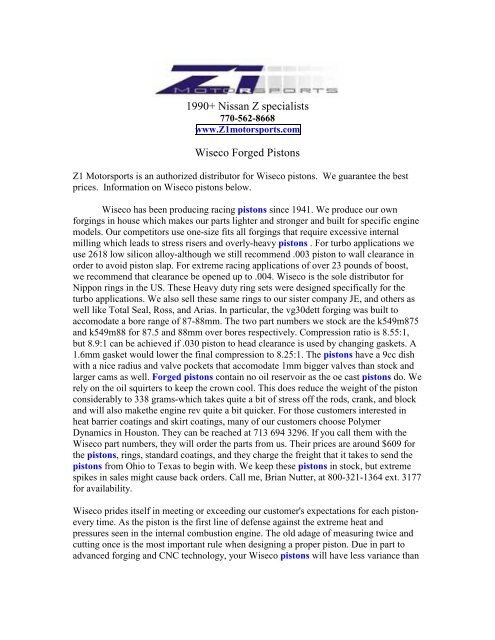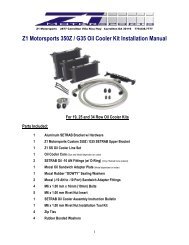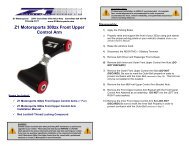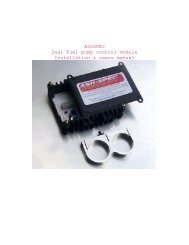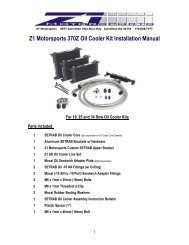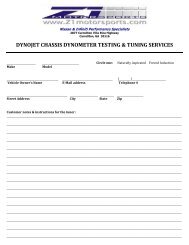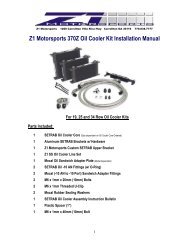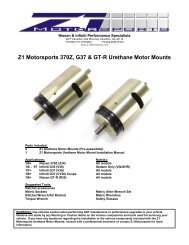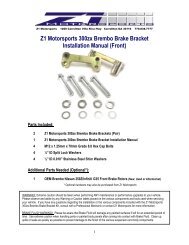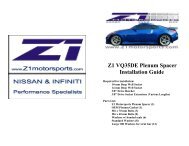Wiseco has been producing racing pistons since ... - Z1 Motorsports
Wiseco has been producing racing pistons since ... - Z1 Motorsports
Wiseco has been producing racing pistons since ... - Z1 Motorsports
You also want an ePaper? Increase the reach of your titles
YUMPU automatically turns print PDFs into web optimized ePapers that Google loves.
1990+ Nissan Z specialists<br />
770-562-8668<br />
www.<strong>Z1</strong>motorsports.com<br />
<strong>Wiseco</strong> Forged Pistons<br />
<strong>Z1</strong> <strong>Motorsports</strong> is an authorized distributor for <strong>Wiseco</strong> <strong>pistons</strong>. We guarantee the best<br />
prices. Information on <strong>Wiseco</strong> <strong>pistons</strong> below.<br />
<strong>Wiseco</strong> <strong>has</strong> <strong>been</strong> <strong>producing</strong> <strong>racing</strong> <strong>pistons</strong> <strong>since</strong> 1941. We produce our own<br />
forgings in house which makes our parts lighter and stronger and built for specific engine<br />
models. Our competitors use one-size fits all forgings that require excessive internal<br />
milling which leads to stress risers and overly-heavy <strong>pistons</strong> . For turbo applications we<br />
use 2618 low silicon alloy-although we still recommend .003 piston to wall clearance in<br />
order to avoid piston slap. For extreme <strong>racing</strong> applications of over 23 pounds of boost,<br />
we recommend that clearance be opened up to .004. <strong>Wiseco</strong> is the sole distributor for<br />
Nippon rings in the US. These Heavy duty ring sets were designed specifically for the<br />
turbo applications. We also sell these same rings to our sister company JE, and others as<br />
well like Total Seal, Ross, and Arias. In particular, the vg30dett forging was built to<br />
accomodate a bore range of 87-88mm. The two part numbers we stock are the k549m875<br />
and k549m88 for 87.5 and 88mm over bores respectively. Compression ratio is 8.55:1,<br />
but 8.9:1 can be achieved if .030 piston to head clearance is used by changing gaskets. A<br />
1.6mm gasket would lower the final compression to 8.25:1. The <strong>pistons</strong> have a 9cc dish<br />
with a nice radius and valve pockets that accomodate 1mm bigger valves than stock and<br />
larger cams as well. Forged <strong>pistons</strong> contain no oil reservoir as the oe cast <strong>pistons</strong> do. We<br />
rely on the oil squirters to keep the crown cool. This does reduce the weight of the piston<br />
considerably to 338 grams-which takes quite a bit of stress off the rods, crank, and block<br />
and will also makethe engine rev quite a bit quicker. For those customers interested in<br />
heat barrier coatings and skirt coatings, many of our customers choose Polymer<br />
Dynamics in Houston. They can be reached at 713 694 3296. If you call them with the<br />
<strong>Wiseco</strong> part numbers, they will order the parts from us. Their prices are around $609 for<br />
the <strong>pistons</strong>, rings, standard coatings, and they charge the freight that it takes to send the<br />
<strong>pistons</strong> from Ohio to Texas to begin with. We keep these <strong>pistons</strong> in stock, but extreme<br />
spikes in sales might cause back orders. Call me, Brian Nutter, at 800-321-1364 ext. 3177<br />
for availability.<br />
<strong>Wiseco</strong> prides itself in meeting or exceeding our customer's expectations for each pistonevery<br />
time. As the piston is the first line of defense against the extreme heat and<br />
pressures seen in the internal combustion engine. The old adage of measuring twice and<br />
cutting once is the most important rule when designing a proper piston. Due in part to<br />
advanced forging and CNC technology, your <strong>Wiseco</strong> <strong>pistons</strong> will have less variance than
any other part in your engine. Many tolerances in a <strong>Wiseco</strong> piston are less than one-halfof-one-thousandths<br />
of and inch (.0005).<br />
An engine builder <strong>has</strong> the first and last word when designing, machining, and assembling<br />
an engine project. It is their responsibility to measure and verify every measurement in<br />
the engine. We at <strong>Wiseco</strong> have compiled a list of frequently asked questions to aid the<br />
engine builder. As every engine is different from any other, these answers are not set in<br />
stone. If you have any doubts as to the specifications of your piston in relation to your<br />
specific engine combination, please call your <strong>Wiseco</strong> technical sales representative.<br />
1. Why are my <strong>Wiseco</strong> <strong>pistons</strong> better than <strong>pistons</strong> made by the O.E.'s and aftermarket<br />
piston suppliers?<br />
It all starts with the forging. <strong>Wiseco</strong> starts with certified extruded bar stock and forges<br />
our <strong>pistons</strong> in-house with the world's most advanced forging presses. Most aftermarket<br />
piston companies do not and therefore can't achieve the level of quality control that<br />
<strong>Wiseco</strong> demands. After thorough inspection, that part goes through an extensive heattreat<br />
and finishing process. This makes for an excellent forging with maximum strength<br />
and minimum variance. The other benefit to doing our forgings in-house is making the<br />
finished piston design dedicated to your engine combination. <strong>Wiseco</strong> can forge a variety<br />
of advanced materials including S.A.E. 4032 and 2618 alloys. High silicon 4032 is a<br />
durable and lighter material usually used in naturally aspirated engines. 2618 Alloy is<br />
designed for the rigors of blown, marine, and nitrous applications.<br />
2. What kind of piston to wall clearance can I run?<br />
The usual rule of thumb is .001 for every inch of bore size. The factors that affect this are<br />
cylinder wall thickness (including filled blocks), overall compression height of the piston,<br />
piston material and thickness, and whether a marine engine is to see fresh-water cooling.<br />
Most small blocks get .004 piston to wall clearance and most big blocks get .005 due to<br />
the use of our 2618 high-strength alloy. For heavy blower and nitrous applications,<br />
<strong>Wiseco</strong> recommends adding .001 to the standard clearance. Special note: Clearance<br />
numbers are taken 1.300 down from the oil ring land-Not 90 degrees from pin centerline.<br />
3. What are the most important factors in deciding what piston fits my engine<br />
combination?<br />
There are many important factors, which we will explain in depth, but the first two are<br />
bore and compression height. Bore size is important for obvious reasons. With the<br />
different block, stroke, and rod combinations, <strong>Wiseco</strong> <strong>has</strong> designed a large number of<br />
<strong>pistons</strong> with varying Compression Heights. This number is the distance from the center<br />
of the wrist pin to the deck of the piston (not dome). When adding 1/2 the stroke + rod<br />
center to center length + Compression height, our goal is to have the piston adequate<br />
piston to head clearance without being excessive (which causes a loss of compression and<br />
quench).
4. What is minimum piston to head clearance?<br />
Generally the factors that decide this are: Piston Speed, Piston Mass, and Rod Material<br />
(Steel or Aluminum). Aluminum Rods generally require .010 more clearance than steel<br />
rods. Steel rods in a big block usually require .045. Steel rods in small blocks require at<br />
least .036. Most imports can get by with as little as .030 depending on piston mass.<br />
*Remember, a compressed gasket thickness can vary from .025 in steel shim applications<br />
to .040 for composite and up to .100 for some copper gaskets.<br />
5. Why do you use piston speed versus rpm to determine the loading in tension of the<br />
block, crank, rods, and pins?<br />
For example a 434 C.I. stroker small block turning 7000 Rpm <strong>has</strong> the same average<br />
piston speed as a 350 turning 8045 rpm, a 327 turning 8615, or a 302 turning 9330 rpm. It<br />
is important to note that average piston speed is only about 2/3rds of what peak piston<br />
speeds can be due to the accelerations seen when the crank is between 45 and 90 degrees<br />
away from TDC or BDC. Rod length is a major factor in maximum velocities.<br />
6. Now the part physically fits in my engine, what factors determine the part I choose?<br />
The most important issue is to have a piston that is built for the right application.<br />
Material, thickness and pin choice are the major factors. While a super light piston rated<br />
at 500hp may have a .150 crown thickness, a Nitrous/blower/Marine application needs<br />
between .220 and .250. Skirt thickness can vary from .110 to .150 depending on the<br />
application and rod angle severity at BDC.


